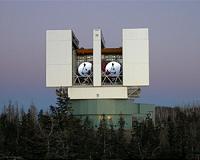 |
London, UK (SPX) Dec 10, 2010 This dramatic image is the first to be produced by e-MERLIN, a powerful new array of radio telescopes linked across the UK. Spearheaded by the University of Manchester's Jodrell Bank Observatory and funded by the Science and Technology Facilities Council, the e-MERLIN telescope will allow astronomers to address key questions relating to the origin and evolution of galaxies, stars and planets. To demonstrate its capabilities, University of Manchester astronomers turned the new telescope array toward the 'Double Quasar'. This enigmatic object, first discovered by Jodrell Bank, is a famous example of Einstein's theory of gravity in action. The new image shows how the light from a quasar billions of light years away is bent around a foreground galaxy by the curvature of space. This light has been travelling for 9 billion years before it reached the Earth. The quasar is a galaxy powered by a super-massive black hole, leading to the ejection of jets of matter moving at almost the speed of light - one of which can be seen arcing to the left in this new e-MERLIN image. The warping of space results in a 'gravitational lens' producing multiple images of the same quasar - the two brightest of these lensed images can be seen here as two bright objects, one below the other. The foreground galaxy whose mass is responsible for the lensing effect is also visible just above the lower quasar image. The radio emission seen in the e-MERLIN image suggests that this galaxy also harbours a black hole, albeit somewhat smaller. The UK's national facility for radio astronomy, e-MERLIN is now set to produce increasingly-detailed radio images of stars and galaxies using seven telescopes spread up to 220 km apart across the UK and working as one. This combination of widely-spread telescopes provides astronomers with a powerful 'zoom lens' with which they can study the fine details of astronomical events out towards the edge of the observable universe. The radio signals collected by the telescopes are brought back to Jodrell Bank using a new optical fibre network. These fibre links and advanced electronic receivers will allow astronomers to collect far more data and so see in a single day what would have previously taken them more than a year of observations. In parallel with this successful demonstration of the new telescope system, work has begun on 'early science' observations intended to rigorously test its capabilities. The project has attracted astronomers from over 100 institutes across the world who will use e-MERLIN to study a huge range of astrophysics. This includes star birth and death, black holes and galaxy evolution, pulsars (the collapsed cores of exploded stars) and young planets forming around nearby stars. The e-MERLIN project has been funded by STFC, the Northwest Development Agency, The University of Manchester, The University of Cambridge and Liverpool John Moores University. It is being operated by STFC and the University of Manchester. Minister for Science and Universities, David Willetts said: "The image produced by the e-Merlin telescope is inspiring to all with an interest in the space sector. "I am confident this impressive project will reap significant scientific rewards - it demonstrates how effective British universities are in this field." Professor Simon Garrington, Director of e-MERLIN at the University of Manchester, says "This first image demonstrates the success of the complex new system of electronics and optical fibre links. "It is also testament to the hard work put in by our engineers, scientists and technicians to turn our vision of a huge fibre-connected array of telescopes into a reality. We are very much looking forward to the new scientific results that will flow from the telescope over the coming years." STFC's Professor John Womersley said, "e-Merlin is a flagship project for the UK in radio astronomy, a scientific field where the UK has a rich legacy, a strong future, and is proud to be the home of some of the very best researchers in the world. "The project has attracted more than 300 astronomers from over 100 institutes in more than 20 countries who will use the power of this 'super telescope' to conduct major scientific legacy projects." Professor Mike Garrett, General Director of ASTRON, the Netherlands Institute for Radio Astronomy, said "e-MERLIN is going to be a transformational telescope - astronomers around the world can't wait to get their hands on it. "As a pathfinder for the next-generation international radio telescope, the Square Kilometre Array, e-MERLIN represents another giant leap forward for the global radio astronomy community."
Share This Article With Planet Earth
Related Links UK Science and Technology Facilities Council Space Telescope News and Technology at Skynightly.com
 Double Vision: New Instrument Casts Its Eyes To The Sky
Double Vision: New Instrument Casts Its Eyes To The SkyPasadena CA (SPX) Dec 10, 2010 The Large Binocular Telescope Interferometer has taken its first images of the star Beta Peg in the constellation Pictor - an encouraging start for an instrument designed to probe the cosmic neighborhoods where Earth-like planets could exist. Eight years in development, the NASA-funded instrument combines beams of light from twin 8.4-meter (28-foot) mirrors mounted atop the Large Binocular ... read more |
|
| The content herein, unless otherwise known to be public domain, are Copyright 1995-2010 - SpaceDaily. AFP and UPI Wire Stories are copyright Agence France-Presse and United Press International. ESA Portal Reports are copyright European Space Agency. All NASA sourced material is public domain. Additional copyrights may apply in whole or part to other bona fide parties. Advertising does not imply endorsement,agreement or approval of any opinions, statements or information provided by SpaceDaily on any Web page published or hosted by SpaceDaily. Privacy Statement |